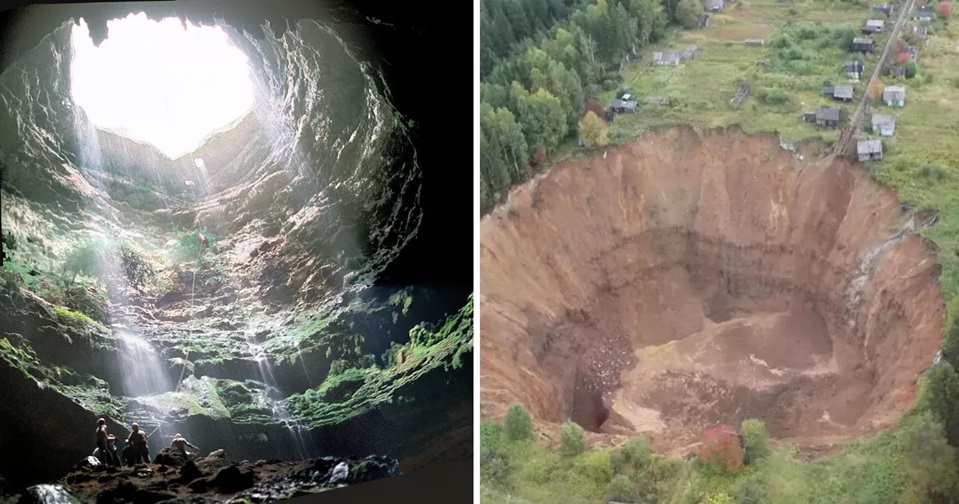Sinkholes are sudden holes that open up in the ground when the surface layer drops into empty spaces below. They can be as small as a dip in a garden or so big that they swallow houses, cars, and even whole streets. To understand sinkholes let's find out how sinkholes are formed, why some are more dangerous and the some of the deadliest sinkholes around the world.
How Sinkholes Form in a Natural Way
Most sinkholes form in places where the rock under the ground can slowly dissolve in water, such as limestone, dolomite, or gypsum. Rainwater becomes slightly acidic after mixing with gases in the air and soil, and over many years it eats away at these rocks, creating gaps and hidden caves underground. As time passes, the roof of one of these caves may weaken until it can no longer hold up the weight above it. When that happens, the surface suddenly collapses, creating a sinkhole. This process can take hundreds of years, but once the ground gives way, the collapse can happen very quickly and with dramatic force.
Can Human Actions Trigger Sinkhole Formation
While sinkholes often form naturally, human actions can make them happen faster or more often. Pumping too much water from underground lowers the water level and removes the support that keeps the ground steady. Mining and drilling can leave empty spaces or weaken the layers of rock. Broken water or sewage pipes can slowly wash away the soil until the surface caves in. Building heavy structures on soft or weak ground can also cause the earth to collapse. Because of these activities, towns, cities, and farmland tend to have more sinkholes than areas left untouched.
Why Sinkholes Are Dangerous
Sinkholes are dangerous because they often appear suddenly and can grow big enough to swallow cars, houses, or whole roads. In some areas, they are linked to complicated underground cave systems, which makes fixing the damage costly and difficult. When they happen in towns or cities, a single sinkhole can cut off power or water, pollute supplies, force people to leave their homes, and even cause deaths. Even very large sinkholes that do not directly threaten lives can still create long-term problems by changing how water flows and making the surrounding land unstable.
The Most Dangerous Sinkholes in the World
Xiaozhai Tiankeng, China
Xiaozhai Tiankeng in China is known as the world’s biggest and deepest sinkhole. It is an enormous hole with steep, vertical walls that drop hundreds of metres. Its dimensions are approximately 626 m long, 537 m wide, and between 511 and 662 m deep. The cliffs around it are very dangerous, as loose rocks can fall and the edges give way suddenly.
This natural sinkhole was formally “discovered” by geologists (outside the local population) in 1994 during exploration by the China Caves Project. Its huge size shows just how powerful natural processes underground can be.
Great Blue Hole, Belize
The Great Blue Hole in Belize is a giant natural sinkhole in the sea and is well known among divers. It is very deep with steep sides that drop suddenly, making it risky to explore. While it doesn’t threaten people on land, it can be dangerous for divers who are not experienced or ready for the challenges of deep water.
Bayou Corne, Louisiana, USA
The Bayou Corne sinkhole in Louisiana, USA, was caused when an underground salt dome collapsed. It became evident on August 3, 2012, when residents were evacuated after signs of collapse in an underground salt cavern.
The ground gave way so suddenly that an entire nearby community, about 350 people, had to be evacuated. Gas was released, and the area has remained unstable ever since, showing how industrial activity underground can lead to long-lasting and dangerous problems.
Sinkholes in Guatemala City, Guatemala
The Guatemala City sinkhole is a well-known example of a massive collapse in the middle of a busy city. About 5 people were killed and around 1000 people were evacuated when this sinkhole opened in a densely populated area on 23rd February 2007. This 100-metre-deep sinkhole swallowed buildings and roads putting residents and emergency workers in serious danger.
On 30th May, 2010, another sinkhole was created in Guatemala City. This sinkhole was about 65 feet in diameter and 300 feet deep and swallowed a 3-storey factory. It happened when old drainage systems, heavy rainfall, and weak ground all impacted together.
Seffner sinkhole, Florida largely residential collapses, USA
In Seffner, Florida, and other nearby areas, several sinkholes have opened up under houses and streets, with one incident sadly taking a life on 28th February in 2013. It swallowed residential structure, vehicles, street, nearby shops, etc.
The ground soil of that area is made of limestone, which dissolves easily, and changes in groundwater levels, along with heavy building and development, make this part of Florida especially likely to experience sudden and dangerous sinkholes.
Winter Park sinkhole and other Florida incidents, USA
In Winter Park, an approximately 100-metre-wide and about 100-foot-deep sinkhole was created on 8th May 1981.
Several more sinkholes created in other places in Florida, sinkholes have shown how dangerous it can be when the ground gives way under built-up areas. Even smaller sinkholes can damage house foundations, cut off power or water lines, block roads, and cause expensive repairs. In some cases, people have even had to leave their homes because of the damage.
Devil’s Sinkhole, Texas, USA
The Devil’s Sinkhole in Texas is a huge vertical cave that is home to thousands of bats. This natural sinkhole was first discovered (in modern times) by a ranch foreman, Ammon Billings, in 1876. While it is an impressive natural sight, it is also very dangerous because of its steep drop, loose edges, and the difficulty of carrying out a rescue. The entrance shaft is about 50 feet wide. The cavern inside is roughly 320 feet in diameter and about 350 feet deep.
Several casualties occurred in and around this sinkhole. For this reason, it should not be explored without expert guidance.
Berezniki sinkhole and mining-related collapses, Russia
In Berezniki, Russia, and other mining areas, sinkholes keep appearing from October 2006, where the ground has been weakened by underground mining. In 2007, a large sinkhole called The Grandfather appeared on the surface, which was about 150 m from the centre of the danger zone. Its initial size was about 55 by 80 metres. The sinkhole expanded later. By the end of 2008, the size stabilised at about 440 by 320 in diameter.
Besides these, some more sinkholes were created in that area from 2010 to 2017. These holes have swallowed buildings and other structures, leaving the land unstable for years. When man-made tunnels and natural ground movement combine, the result can be some of the most destructive sinkholes seen.
Yucatán cenotes, Mexico
The Yucatán region in Mexico is full of cenotes, which are natural sinkholes created when caves collapse and then fill with water. They are important for both culture and nature, but some can be dangerous. Many have steep vertical drops, hidden underwater cave systems, and strong currents that have caused accidents, especially when the cenotes are not clearly marked.
Collapsed road and infrastructure sinkholes, worldwide
Some of the most dangerous sinkholes around the world are not the giant natural ones but the smaller ones that suddenly open under roads, bridges, or utility lines. When a busy highway or bridge collapses, it can cause chaos right away, affecting thousands of people. These sinkholes can also lead to other problems, such as fuel leaks or landslides, making the situation even more serious.
Conclusion
Sinkholes show us how nature and human activity can combine to change the land very quickly. To reduce the risks, it is important to plan carefully where we build, check and maintain old pipes and structures, manage how much water we take from underground, and be cautious in areas where the rock can easily dissolve. If these steps are not followed, sinkholes can appear without warning and become some of the most damaging and dangerous problems for communities.


